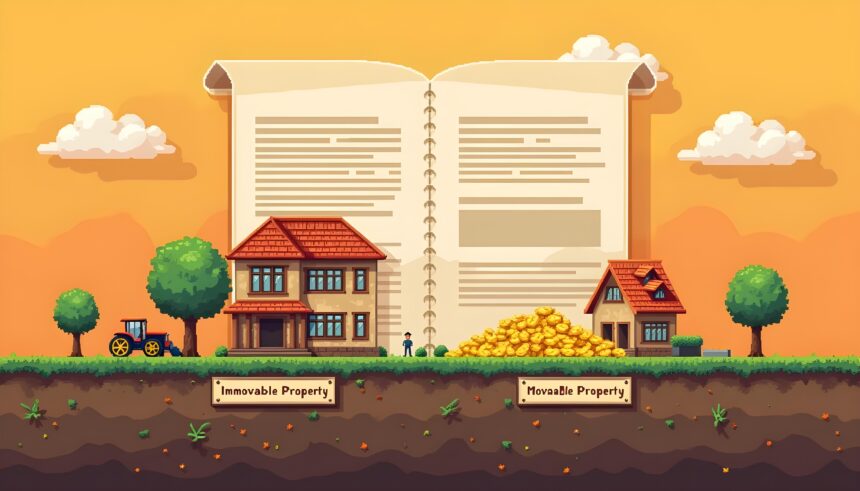Understanding the distinction between movable and immovable property is essential for anyone involved in property transactions, legal agreements, or estate management. These terms define how assets are categorized, handled, and registered, particularly in real estate. Here’s a detailed guide to help you grasp the differences and the legal implications:
1. What is Property?
Property refers to any asset that generates income or profit for its owner. It can be sold, mortgaged, or maintained for long-term gains. The term “property” encompasses various categories, including land, buildings, and other assets that hold value.
2. Defining Property
Property is broadly categorized into two main types: movable property and immovable property. In ancient Sanskrit records, movable property was referred to as “Jangama,” while immovable property was called “Sthavara.”
3. Examples of Movable Property
Movable property includes assets that are not fixed to the ground, such as:
- Gold jewelry
- Stock market investments
- Company shares
While these assets hold significant value, they don’t require registration with the sub-registrar when being transferred, unlike immovable property.
4. Examples of Immovable Property
Immovable property refers to anything permanently attached to the land, such as:
- Land and plots
- Agricultural fields and farms
- Buildings and wells
- Permanent structures, solar plants, and rights to natural resources like water
When buying or selling immovable property, the transaction must be registered in the sub-registrar’s office in accordance with property registration laws.
5. Real Estate Deals and Registration
In real estate, most transactions deal with immovable property, meaning that registration is mandatory. Proper valuation is necessary to purchase appropriate stamp papers for these transactions, and any confusion between movable and immovable property can complicate these processes.
6. What Constitutes Immovable Property?
Apart from land and buildings, immovable property includes rights over natural resources (like river water or fish from lakes) and future benefits derived from the land, such as rental income or agricultural yield.
7. Industrial Machinery as Immovable Property
Machinery in factories that is fixed to the land is also considered immovable property if sold along with the land. However, if machinery is sold separately, it is treated as movable property.
8. The Importance of Registration
Movable and immovable property have different requirements for registration:
- Movable Property: No registration is needed if the asset is sold independently of the land.
- Immovable Property: Registration is required when the asset (like machinery) is sold as part of the land.
9. Movable to Immovable Property Conversion
The classification of property can change. For instance, if a company owning land dissolves and partners distribute the land through shares, the land becomes movable property, meaning no registration is required.
10. Hybrid Examples
Movable items, such as machinery, can become part of the immovable property if sold together with land. Conversely, land can become movable property when dealt with as shares in a company.
11. Future Benefits from Land
The potential future income derived from property, such as rent or agricultural produce, is considered part of the immovable property’s value.
12. Rental Income
Rent collected from tenants is considered a benefit of the immovable property and is factored into the property’s overall value during transactions.
13. Rights to Use Land for Public Purposes
Public rights to use land for markets, fairs, and commercial events are also classified as immovable property.
14. Agricultural Products and Movable Property
Crops, grains, grass, and by-products from trees (like fruits, leaves, or sap) are considered movable property since they can be harvested and transferred without the need for legal registration.
15. Distinction Between Trees and Land
Legal rulings have classified trees as immovable property because they are attached to the land. However, products from the trees, such as fruits or leaves, are movable property.
16. Understanding Movable Property
Movable property consists of items that are not permanently affixed to the land, such as harvested crops or other plant-based products. These can be sold, transferred, or moved without legal registration.
17. Why This Knowledge Matters
Understanding the distinction between movable and immovable property is crucial for avoiding unnecessary expenses during real estate transactions. Knowing what requires registration can help prevent errors and minimize costs related to stamp duty and legal fees.
18. Common Confusions in Real Estate
Even legal professionals sometimes confuse movable and immovable property. Being well-informed can prevent missteps and ensure that transactions are properly documented and handled according to law.
Conclusion
Understanding the difference between movable and immovable property helps in navigating real estate transactions more effectively. It ensures proper registration and prevents costly mistakes. Whether dealing with land, machinery, or agricultural products, knowing what constitutes movable or immovable property is essential for any property owner or investor.
If you’d prefer to have everything handled for you seamlessly, you can click here and contact us at verified.realestate. Our team of experts is here to provide comprehensive support and ensure a smooth and secure property buying experience.
